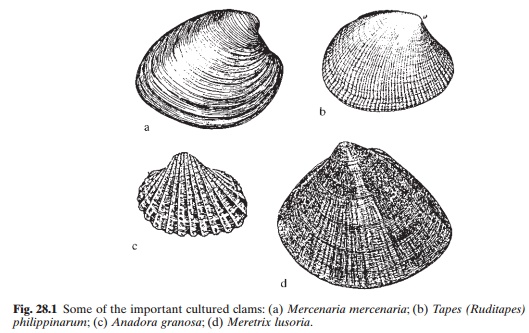Chapter: Aquaculture Principles and Practices: Clams, Scallops and Abalones
Grow-out of Clams
Grow-out
In the final grow-out to market size, different systems of varying
degrees of sophistication are used, ranging from simple sowing on the bottom to
recirculation systems. A cost-effective system developed in the USA involves
the use of covered sub-tidal areas in which baffles, pens or net tents are used
together with crushed stones for protection of the seed and prevention of
siltation. A stocking density of up to 4300 seed/m2 is possible in such beds.
However, thinning of the stock to about half the original density is necessary
as the clams grow in size. The grow-out period is generally two to three years,
depending on local conditions, and the market size is 4 to 4.5cm shell length.
Tray culture allows higher densities of stock and many farms in the USA have
used them successfully in the grow-out of M.
mercenaria.
Clams of the genus Meretrix,
especially M.meretrix and M. lusoria, are cultured in the
FarEast. The common species cultured in Taiwan is M. lusoria. Its culture is somewhat unique anddifferent from those
described above in that it is often grown in association with milkfish in the
inlet and outlet channels of pond farms. It is also cultivated on sandy flats
and tidal estuaries.
Seed clams are collected from coastal areas with rakes operated from
small boats, mainly during summer, although seed can be found throughout the
year. The seed clams of about 0.5mm length are sold to seed clam growers, who
rear them in shallow brackish-water ponds. If the ponds are not fertile enough,
organic fertilizers are applied to promote growth of phytoplankton. The water
is exchanged every three to four days. The stocking rate is about 30–50 million
seed/ha. Where possible, the growing clams are sorted according to size and
replanted separately. In about six months they reach a size equivalent to
800–1000 clams per kg and are ready for sale to farmers who grow them to market
size.
Grow-out may be in sandy tidal flats, estuarine areas or in fish pond
facilities. Beds with a high content of sand (at least 50 per cent) are
selected as such bottoms provide for the bur-rowing of the clam and also seem
to promote the attractive pink coloration which is important in marketing. In
such areas it is usual to install fences of net mesh to prevent the escape of
clams and the entry of predators. The stocking rate generally varies from
2000–5000kg seed clams of 600 per kg size in ponds, to as low as 100kg per ha
on sandy flats. They are spread evenly on the bottom. A size of 35 per kg may
be reached in about 18 months. Harvesting from ponds is done by hand and from
estuaries and tidal flats with rakes fitted with a net bag for holding the
collected clams.
The clam that is important in several countries of Asia is the cockle or
the blood cockle Anadora granosa. It
is cultured on a limitedscale in most countries of the region, including China
and Taiwan, and is found on muddy estuarine flats and bays with weak tidal
currents and waves. The spawning season varies with the locality, e.g. in China
from July to September and in Taiwan from January to April. The spat settle on
fine, sandy mud flats in the lower intertidal areas.
Cockle culture is relatively simple and mainly consists of collecting
natural spat and planting them in protected beds for rapid growth. The sites
generally selected have soft muddy bottoms with 2–2.5m water at high tide. In
Thailand, shrimp farmers often use elevated parts of their ponds for cockle
growing. Exposure of the bed for more than about six hours and sudden changes
in salinity due to heavy rains can cause serious mortalities. Areas under
cockle culture are often fenced in to prevent poaching. In Taiwan, the spat are
generally nursed in specially prepared mud flats enclosed by fencing of nylon
netting. They are grown to a size of 5000 per kg and then sold to farmers who
grow them to market size. Some of the seed producers operate their own grow-out
farms. Stocked at the above size, the cockles grow to 500–600 per kg in one year
in Taiwan. The minimum market size is 120 per kg and to reach that size it
usually takes two to three years or more. During this period the farmer tries
to eradicate predators and pests, such as wild ducks, crabs, sea snails and
puffer fish. Harvesting is generally done manually.
Relatively fewer clam or cockle diseases have been reported. Many of the
known diseases of juveniles and adult clams are caused by the haplosporidian Perkinsus marinus, the coccidian Hyaloklossia and Pseudoklossia, the gregarine
Nematopsis and ciliates like
Trichodina and Ancistrocoma.

Related Topics